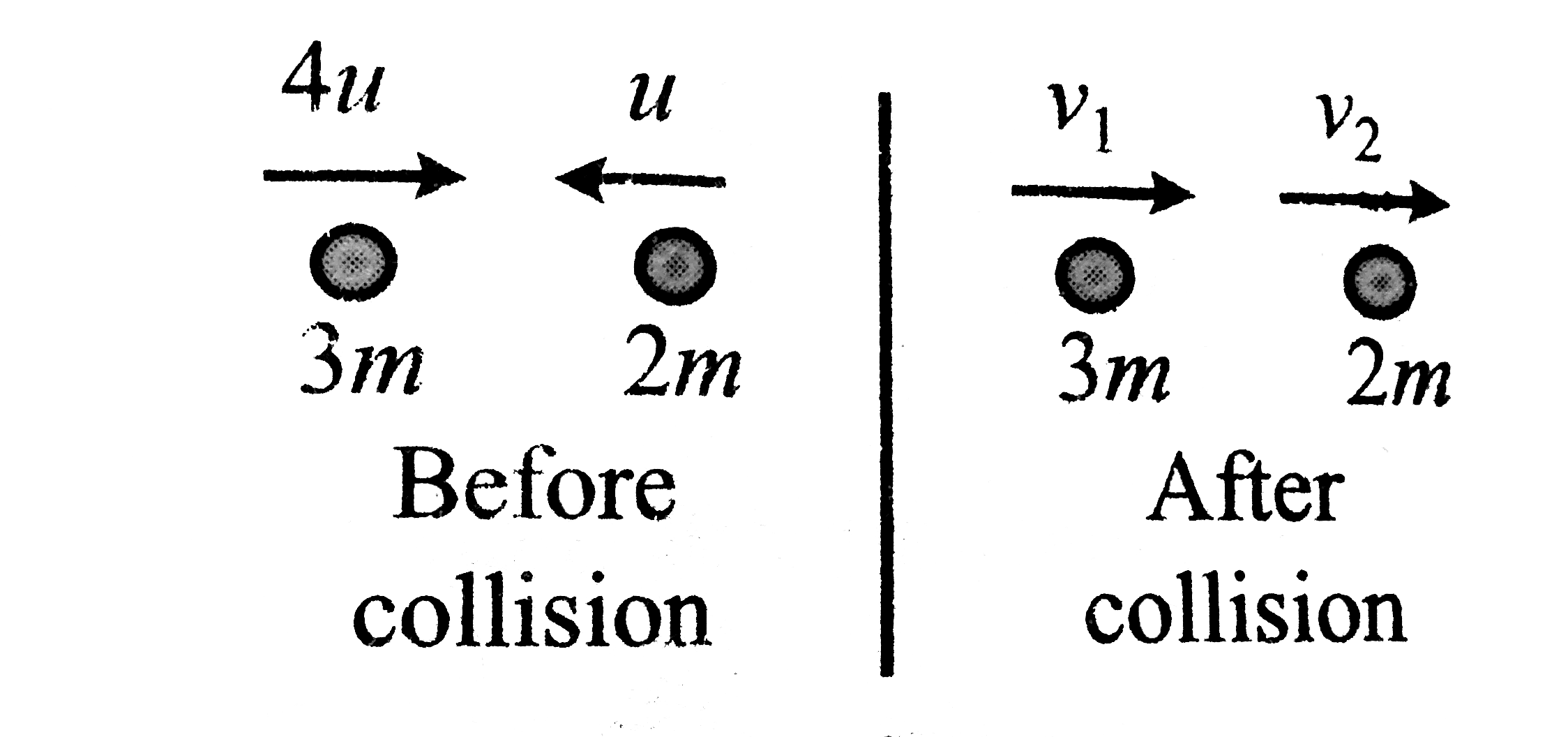Two small spheres A and B of equal radius but different masses of 3m and 2m are moving towards each other and impinge directly. The speeds of A and B before collision are, respectively, 4u and u. The collision is such that B experiences an impulse of magnitude 6mcu, where c is a constant. Determine
a. the coefficient of restitution,
b. the limits for the value of c for which such collision is possible.
The correct Answer is:e=c−1,1≤c≤2
Using conservation of momentum

m1u1+m2u2=m1v1+m2v2
Putting the values we get
(3m)(4u)−(2m)u=3mv1+2mv2
⇒3v1+2v2=10u……..i
Using equation of restitution
v2−v1=5ue ..........ii
From i and ii v2=2u+3eu
Now impulse on m2:
J=2mv2−(−2μ)
Put the value of J and v2 to get e=c−1
As 0≤e≤1⇒1≤c≤2
Topper's Solved these Questions
- CENTRE OF MASSBOOK - CENGAGE PHYSICSCHAPTER - CENTRE OF MASSEXERCISE - Single Correct
141 Videos
- CENTRE OF MASSBOOK - CENGAGE PHYSICSCHAPTER - CENTRE OF MASSEXERCISE - Multiple Correct
25 Videos
- CENTRE OF MASSBOOK - CENGAGE PHYSICSCHAPTER - CENTRE OF MASSEXERCISE - Exercise 1.3
24 Videos
- CALORIMETRYBOOK - CENGAGE PHYSICSCHAPTER - CALORIMETRYEXERCISE - Solved Example
13 Videos
- DIMENSIONS & MEASUREMENTBOOK - CENGAGE PHYSICSCHAPTER - DIMENSIONS & MEASUREMENTEXERCISE - Integer
2 Videos
Similar Questions
Two particles A and B of equal size but of masses mkg and 2mkg are moving directly towards each other with speeds 21m/s and 4m/s respectively. After collision, A moves with a speed of 1m/s in the original direction. Then:
View SolutionTwo particles A and B of equal size but of masses m kg and 2 m kg are moving directly towards each other with speeds 21 m/s and 4 m/s respectively. After collision, A moves with a speed of 1 m/s in the original direction. Then:
View Solution
Knowledge Check
A sphere A impinges directly on an identical sphere B at rest. If coefficient of restitution is e , the ratio of velocities of A and B after collision is
A1−e1+eB1+e1−eCe1+eD2e1+eTwo balls of masses 2m and m are moving with speed 2v0 and v0 towards each other. If the coefficient of restitution e=1/3 , the speed of balls , if collision is head - on
Av03,4v03B2v03,5v03C2v03,4v03Dv03,2v03A sphere of mass m moving with a velocity u hits another stationary sphere of same mass. If e is the coefficient of restitution, what is the ratio of the velocities of two spheres after the collision?
A1BeC1+e1−eD2−e1+e
A collision occurs between two identical balls each of mass m, moving with velocities →u1 and →u2, colliding head-on. The coefficient of restitution is 0.5. The energy lost in the collision is:
View SolutionTwo smooth spheres. A and B. having equal radii, lie on a horizontal table. A is of mass m and B is of mass 3m. The spheres are projected towards each other with velocity vector 5ˆi+2ˆj and 2ˆi−ˆj, respectively, and when they collide the lige joining their centres is parallel to the vector ˆi. If the coefficient of restitution between A and B is 1/3, find the velocities after impact and the loss in kinetic energy caused by the collision. Find also the magnitude of the impulses that act at the instant of impact.
View SolutionTwo smooth spheres. A and B. having equal radii, lie on a horizontal table. A is of mass m and B is of mass 3m. The spheres are projected towards each other with velocity vector 5ˆi+2ˆj and 2ˆi−ˆj, respectively, and when they collide the lige joining their centres is parallel to the vector ˆi. If the coefficient of restitution between A and B is 1/3, find the velocities after impact and the loss in kinetic energy caused by the collision. Find also the magnitude of the impulses that act at the instant of impact.
View SolutionTwo spheres are moving towards each other. Both have same radius but their masses are 2kg and 4kg. If the velocities are 4m/s and 2m/s respectively and coefficient of restitution is e = 1/3, find.
impulse of reformation.
View SolutionA sphere of mass m moving with a constant velocity u hits another stationary sphere of the same mass. If e is the coefficient of restitution, then ratio of velocities of the two spheres after collision will be
View Solution
